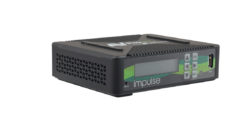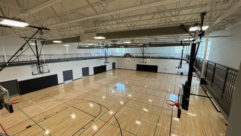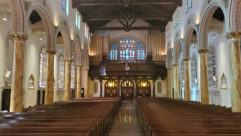
Emergency Audio for Worship, Part 1
Jun 10, 2013 11:49 AM,
With Bennett Liles

Listen to the Podcasts
|
Related Story: Automated Expertise

Editor’s note: For your convenience, this transcription of the podcast includes timestamps. If you are listening to the podcast and reading its accompanying transcription, you can use the timestamps to jump to any part of the audio podcast by simply dragging the slider on the podcast to the time indicated in the transcription.
At St. Lucy Parish, the church members had been putting off upgrading the church’s sound system until the old one finally died and it became an emergency. Mike Dow at Zamar Media Solutions in San Jose had been looking at the church’s needs and already had a plan ready to go. He’s here to tell us what Zamar Media Solutions did to save the day, coming right up on the SVC Podcast.
Mike, thanks for being with us on the SVC Podcast from Zamar Media Solutions in San Jose, Calif. That’s kind of an interesting name and I know you had a big sound system revamp at St. Lucy Parish. It looks like they were long overdue for one. Tell me what’s been happening at Zamar Media Solutions. What’s been going on there?
Well, we’ve been keeping pretty busy despite the downturn in the economy. We’ve got a lot of customers that have been waiting to do upgrades for the last couple of years and so they’re starting to percolate up to the top of the heap, so to speak, and they are scaled back in scope a lot of times, but the St. Lucy project was one that was long overdue and that we’ve been working on for probably about six years trying to get the process to complete. And they finally had a system failure, which brought us to the table again. [Timestamp: 1:36]
Yeah, nothing like the whole sound system collapsing to finally get the people in gear on fixing it. Now I think they had an upgrade in mind some time ago and just put their plans on ice for a while probably with budget concerns. What sort of a church is St. Lucy Parish? What sort of a worship style do they have there?
Well, that was one of the challenges—the variety of worship styles. There are various types of congregations, ethnic groups that meet there. It’s a Catholic church, but they have very, very diverse groups, so it presented some challenges for us. Sometimes it’s just choir, organ, and the liturgy. And then other times it’s a full band in front of a small choir and it varies quite a bit. It required us, during the commissioning process, to actually bring in each of those groups, dial in on the mixer—the digital PreSonus mixer—each of those groups and gave them fader control and the basics that they needed, which is all they were used to doing, but with a little bit of experience on our part to make sure that things were dialed in and sounded good when they fed the larger system. [Timestamp: 2:44]
And of course a digital mixer with recallable presets can make it much easier for non-pro audio people to get up and running with it. But they had the old system that wasn’t working. So what did they say when they called you up, ‘Help, come rescue us,’ or what?
Absolutely. That was pretty much the call that I got from Michael Wentz, the coordinator there. And he’s very tech savvy; [he] came out of the Silicon Valley here in the computer industry, so he was very cognizant of what he wanted, what he needed. He participated in the design process, and that’s why we were so successful in this because we had an inhouse person who knew what they wanted as opposed to the typical customer who knows what they don’t like but not sure what they do like. So it made for a very successful design process, and the end result was pretty much astounding. The initial system that was in there was all pretty much conference room ceiling speakers about 20ft. to 25ft. in the air, with no delays, nothing. Everything was small-rack, round-knob mixers with fingernail polish where the knob should be, and was subject to continual fooling around by various folks who thought they knew better, which created everything from distortion to blown speakers to just generally bad sound. So they were looking for a pilotless system that allowed them to hit a button, recall things, and make minor adjustments once that recall was done, which now that we’ve been several months into operation has been totally successful and they’re very pleased. [Timestamp: 4:21]
And the old system that was in there, since it went down, I guess there wasn’t much, if any of it, that you could repurpose and reuse in the new setup. The churches want you to do sometimes.
That’s correct. We reused maybe, I think, one small amplifier for their lobby and some remote speakers. Everything else was replaced. We had done the video work about four years ago and had rebuilt that portion of the rack, so we reintegrated the new audio with our old video and rebuilt the entire rack system for them; brought in new power to handle the larger amplifiers, so it was an interesting process. One of the interesting things they did was they requested I leave one of those mixers in there that wasn’t hooked up so people that liked to play can come back and play with the knobs that didn’t do anything. [Timestamp: 5:12]
Emergency Audio for Worship, Part 1
Jun 10, 2013 11:49 AM,
With Bennett Liles
Well, maybe with some of them that’s the safest way to go.
Absolutely.
Like with the kid’s steering wheel in the back seat.
Yeah, yeah. Keep ‘em happy.
I saw a picture of this one and that’s some very interesting architecture; kind of unusual. Did you have to do any kind of acoustic treatment in there?
Well clearly the system we installed was intended to not over-aggravate the acoustics, hence the line arrays—the small Martin line arrays—but there’s still an echoing parallel wall issue and we did bid acoustics. It was considered a ‘let’s do it in Phase II.’ I think they’ll still do it, but we did some things to really take care of that. One of the things we did was install infrared mic mutes on each of the podiums that are there, and that changed the reproduction of sound drastically because it no longer was picking up what reflections were happening upon the altar area. And so the mic mutes were critical to not letting the acoustical issues exacerbate the delivery of sound to the congregation. [Timestamp: 6:14]
Well that was kind of an ingenious solution on the mic channels. I noticed you used the Symetrix Symnet Radius in there. What was the attraction there? Why did you decide to use that for this one?
A couple of reasons. We had originally specified the Express Cobra unit, which was their older unit. They came out with the new unit during the development phase of the design, the Radius, which we believe to be great, number one, because it had the Dante communication bus, which allowed us to build a more extensive infrastructure plus the DSP horsepower. Also, we’re very comfortable with the programming. We use the touchscreen system to control the parameters, which was supplied by Extron. But the Radius is truly the heart of the system and gave us the capability to have feedback control where we needed it for the choir mics that come in and just really provided the quality of sound we were looking for and the programmability that we needed because we knew we were going to have to do both front-end programming of various microphones as well as the outward processing DSP for the speakers. So that unit just provided that for us and gave us a larger quantity of inputs than we would have had using a more traditional eight by eight, eight-in-eight-out unit. [Timestamp: 7:30]
And with the Symetrix you’re dealing with the Dante protocol and with digital audio nowadays there’s no shortage of competing formats. What was good about using the Dante protocol for this? Was it more because it was just a part of the hardware you chose or was there a definite advantage to the Dante protocol itself?
Good question. I think audio quality, being one of which, latency being another, and also the flexibility of them eventually down the road allowing that Dante bus to go to a multitrack processor or excuse me, a multitrack recorder or possibly even allow them to move signals around the facility. It is a very large campus and that was of interest to them not initially, but down the road. [Timestamp: 8:13]
Yeah, when you go to expand that system I guess that would come into play quite a bit to be able to add on elements that will be compatible with what you already have in there. And with the unusual architectural layout, one of the big things in this was the speakers, the type you used and where they were installed.
Because the room is not your traditional stage with seats in front, it’s almost, if you will, a church in the round, so to speak, on at least three sides of the stage; [there’s] not much depth on the sides. So we put in two single cluster Martin line arrays on each side and then feeding the longer depth of the room, we put two more line arrays that were the two clusters or eight individual boxes per side, and that gave us the coverage and the throw that we needed. And also we added the Martin subwoofers, which are uniquely placed almost in the center of the room very high up in the white ceiling that they had. So we ended up putting some light gray boxes up there, which look almost like the old light boxes and the old speaker boxes that are up there. So almost no one even noticed that we put the low-frequency modules in. They had never had subwoofers with the old system; it was just the ceiling speakers as I mentioned, and so when they walked around and heard the Martin line arrays, the coverage, the clarity, the throw, they were just amazed. And then coupling that with the Radius DSP, we were able to decide what things fed the side speakers and the front speakers, which gave us a lot of control over not putting sound where the choir was. In a typical Catholic church, the band and the choir is more or less out in the congregation, away from the altar area. So the altar area is protected from sound, but the choir was not. Since we had four outputs, one feeding each cluster, we were able to not put the choir and the band feeding into its own microphones, which helped a lot with our feedback and our clarity of the various, what they call band choirs. [Timestamp: 10:17]
Yeah, the architecture in there and the fact that it’s such varied types of services they have, that’s really a strange mix. You don’t see that a lot so I’m sure that made things pretty interesting to get a system up that could handle it all. Did you have any other architectural or electrical challenges on this one?
A little bit. We did use the Powersoft amplifiers, so we ended up having very low power draw needs to drive the system. So we only had to bring a couple of circuits in, which turned out to be only a minor challenge for them. When we did tear the racks apart, we did discover that what looked like two or three circuits ended up being one spread out over several quad boxes. So it created a little bit of a problem, but it was easy to solve. [Timestamp: 11:02]
Well, I’m sure it wasn’t a dull job with so many different requirements in that sort of in-the-round performing environment. In part two we’ll get more into the front end, the microphone end of the new system. Thanks for taking the time. Mike Dow with Zamar Media Solutions in San Jose, Calif., and the St Lucy Parish new sound system. We’ll see you then, Mike.
Thank you very much.










